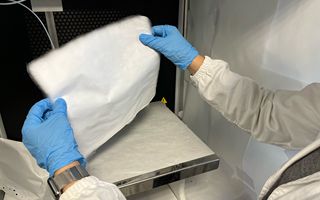(Finance) – A biodegradable patch that heals skin lesions thanks to a patented ointment incorporated into its nano fibers. They’ve fine-tuned it ENEA and Nanofaber, spin off of ENEA itself, with the aim of reducing the frequency of medications and, consequently, pain and the risk of infections. The contents of this innovation were published in the Pharmaceutics magazine.
“To create this particular multilayer, biocompatible and biodegradable patch, an innovative technique was used, called electrospinning or electrospinning. This is a production process used in both the industrial and scientific fields and serves to produce nanostructured membranes that allow the medicine to be encapsulated and to release it in a gradual and controlled way, once in contact with the wound”, he explains Antonio Rinaldi, ENEA researcher and co-founder of Nanofaber.
The patch prototype it is made up of two external layers composed of a biocompatible synthetic material used in the medical field; in the internal layer, however, there is a phytounguent for the regeneration of damaged skin, patented by ENEA, and is based on a formulation of natural origin made up of Neem oil and oily extract of St. John’s Wort flowers.
“In order to make the most of the regenerative mechanism of the ointment or simply increase its field of applications, we have studied innovative strategies to control its gradual and optimal release with respect to the regeneration phases of the skin tissue – he explains Anna Negroni, researcher at the ENEA Laboratory of Biomedical Technologies –. Thanks to the collaboration with Nanofaber – he adds – a new concept of biomedical patch was born which preserves the therapeutic properties of the ointment and guarantees better bioavailability through gradual release, very useful for a more effective and correct management of the healing of skin lesions. And we should soon move on to a preclinical trial to evaluate its effectiveness also in vivo.”
“Through this patch we have managed to combine, in a satisfactory manner, the medical properties of the phytounguent with nano and micro-structured systems obtained by additive manufacturing, which have allowed us to amplify its applications and therapeutic power”, he remarks Rinaldi.
To check theefficiency of encapsulation and release of the active ingredient on the part of the patch, the researchers carried out accurate spectroscopic and chromatographic investigations. There validation of therapeutic efficacy, however, was conducted using in vitro biocompatibility, cytotoxicity and cell migration tests. The results demonstrate that the electrospun phytounguent does not produce negative effects on cell viability but is able to improve the effectiveness of wound healingas demonstrated by the scratch test which simulated the presence of a wound on a monolayer of cells induced by performing a scratch.
“We found that the cells grown on the membrane containing the encapsulated medication repair the wound faster than the empty membrane. Furthermore, the development of the scratch test conducted in the study – concludes Negroni – is itself a research result because it has allowed us to obtain an in vitro wound healing model, which allows a time-lapse study and of potential general interest for bioengineering and biotechnology”..
